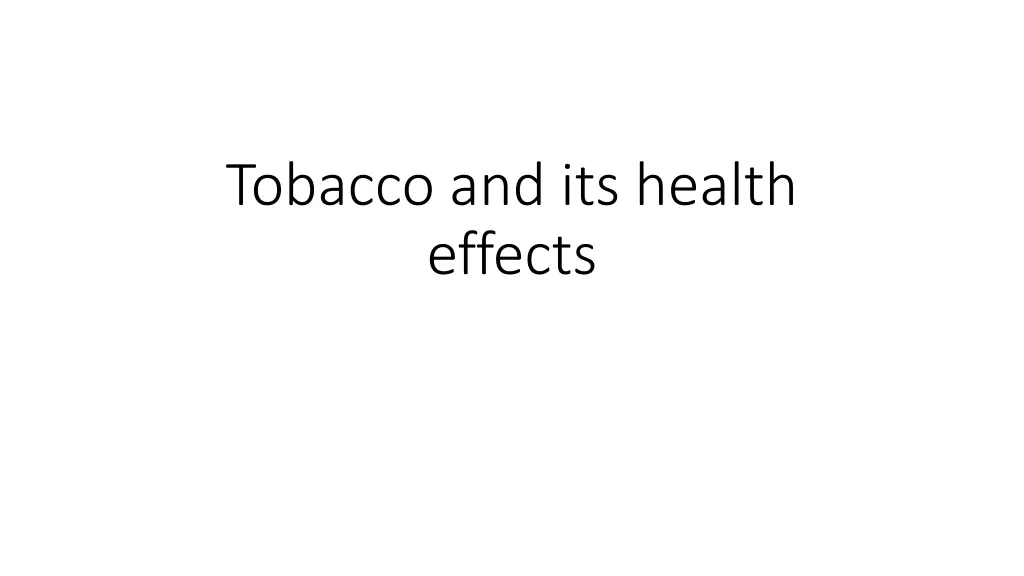
Understanding Tobacco Use and Its Health Effects Worldwide
Tobacco poses a significant public health threat, causing over 8 million deaths annually. The tobacco epidemic affects both users and non-smokers exposed to secondhand smoke. In India, nearly 267 million adults use tobacco, with smokeless tobacco being the most prevalent form. All forms of tobacco, including cigarettes, pose serious health risks, with no safe level of exposure. Waterpipe and smokeless tobacco use also contribute to various health issues, increasing the risk of cancers and other diseases.
Download Presentation

Please find below an Image/Link to download the presentation.
The content on the website is provided AS IS for your information and personal use only. It may not be sold, licensed, or shared on other websites without obtaining consent from the author. If you encounter any issues during the download, it is possible that the publisher has removed the file from their server.
You are allowed to download the files provided on this website for personal or commercial use, subject to the condition that they are used lawfully. All files are the property of their respective owners.
The content on the website is provided AS IS for your information and personal use only. It may not be sold, licensed, or shared on other websites without obtaining consent from the author.
E N D
Presentation Transcript
Tobacco and its health effects
Tobacco The tobacco epidemic is one of the biggest public health threats the world has ever faced, killing more than 8 million people a year around the world. More than 7 million of those deaths are the result of direct tobacco use while around 1.2 million are the result of non-smokers being exposed to secondhand smoke.
Tobacco Key facts Tobacco kills up to half of its users. Tobacco kills more than 8 million people each year. More than 7 million of those deaths are the result of direct tobacco use while around 1.2 million are the result of non-smokers being exposed to second-hand smoke. Over 80% of the world s 1.3 billion tobacco users live in low- and middle-income countries.
Tobacco use is a major risk factor for many chronic diseases, including cancer, lung disease, cardiovascular disease and stroke. It is one of the major causes of death and disease in India and accounts for nearly 1.35 million deaths every year. India is also the second largest consumer and producer of tobacco. A variety of tobacco products are available at very low prices in the country.
Nearly 267 million adults (15 years and above) in India (29% of all adults) are users of tobacco, according to the Global Adult Tobacco Survey India, 2016-17. The most prevalent form of tobacco use in India is smokeless tobacco and commonly used products are khaini, gutkha, betel quid with tobacco and zarda. Smoking forms of tobacco used are bidi, cigarette and hookah.
All forms of tobacco are harmful, and there is no safe level of exposure to tobacco. Cigarette smoking is the most common form of tobacco use worldwide. Other tobacco products include waterpipe tobacco, various smokeless tobacco products, cigars, cigarillos, roll-your-own tobacco, pipe tobacco, bidis and kreteks.
Waterpipe tobacco use is damaging to health in similar ways to cigarette tobacco use. However, the health dangers of waterpipe tobacco use are often little understood by users. Smokeless tobacco use is highly addictive and damaging to health. Smokeless tobacco contains many cancer-causing toxins and its use increases the risk of cancers of the head, neck, throat, oesophagus and oral cavity (including cancer of the mouth, tongue, lip and gums) as well as various dental diseases.
Over 80% of the 1.3 billion tobacco users worldwide live in low- and middle-income countries, where the burden of tobacco-related illness and death is heaviest. Tobacco use contributes to poverty by diverting household spending from basic needs such as food and shelter to tobacco.
The economic costs of tobacco use are substantial and include significant health care costs for treating the diseases caused by tobacco use as well as the lost human capital that results from tobacco attributable morbidity and mortality. In some countries children from poor households are employed in tobacco farming to boost family income. Tobacco growing farmers are also exposed to a number of health risks, including the green tobacco sickness .
Green tobacco sickness occurs from transdermal absorption of chemicals from freshly harvested, green tobacco leaves. Risk of nicotine poisoning increases when the nicotine contained in the tobacco leaves mixes with rain, dew, or sweat, allowing nicotine to get onto the skin and pass into the bloodstream more easily. Signs and symptoms include nausea, vomiting, headache, and abdominal cramps. Prevalence has shifted from the United States and Europe to China, India, and Brazil.
Passive Smoking Second-hand smoke is the smoke that fills enclosed spaces when people burn tobacco products such as cigarettes, bidis and water-pipes. There is no safe level of exposure to second-hand tobacco smoke, which causes more than 1.2 million premature deaths per year and serious cardiovascular and respiratory diseases. Almost half of children regularly breathe air polluted by tobacco smoke in public places, and 65000 die each year from illnesses attributable to second-hand smoke. In infants, it raises the risk of sudden infant death syndrome. In pregnant women, it causes pregnancy complications and low birth weight.
Second-hand tobacco smoke (SHS) kills 600,000 people each year. Globally, about one-third adults are regularly exposed to SHS. The GATS-India shows that 52% of the adults (rural-58%, urban-39%) were exposed to SHS at home. SHS is three- to four-times more toxic per gram of particulate matter than mainstream tobacco smoke. More than 4000 chemicals have been identified in tobacco smoke, at least 250 of which are known to be harmful. Toxic chemicals from SHS cling to rugs, curtains, clothes, food, furniture and other materials. These toxins remain even in the presence of windows, fans or air filters, and can recycle back into the air through the filters. They coat the surfaces of rooms, materials and smoker's belongings, and are sometimes referred to as third-hand smoke.
E-cigarettes Electronic nicotine delivery systems (ENDS) and electronic non-nicotine delivery systems (ENNDS), commonly referred to as e-cigarettes, are devices which heat a liquid to create an aerosol which is then inhaled by the user, these may or may not contain nicotine. The main constituents of the solution by volume are propylene glycol, with or without glycerol, and flavouring agents. E-cigarettes are particularly risky when used by children and adolescents. Nicotine is highly addictive and young people s brains develop up to their mid-twenties. ENDS use increases the risk of heart disease and lung disorders. They also pose significant risks to pregnant women who use them, as they can damage the growing fetus.
Tobacco is deadly in any form or disguise. Scientific evidence has unequivocally established that exposure to tobacco smoke causes death, disease and disability. According to the International Agency for Research on Cancer (IARC) monograph, there is sufficient evidence in humans that tobacco smoking causes cancer of the lung, oral cavity, naso-, oro- and hypo-pharynx, nasal cavity and paranasal sinuses, larynx, esophagus, stomach, pancreas, liver, kidney (body and pelvis), ureter, urinary bladder, uterine cervix and bone marrow (myeloid leukemia). Colorectal cancer is seen to be associated with cigarette smoking, although there is insufficient evidence for it to be causal. Ninety percent of all lung cancer deaths in men and 80% in women are caused by smoking.
There is sufficient evidence in humans for the carcinogenicity of smokeless tobacco. Several studies have established a causal association between use of smokeless tobacco and cancers of oral cavity, esophagus and pancreas. Smokeless tobacco causes acute increases in blood pressure and heart rate, and has been associated with a small increase of cardiovascular disease risk. Effects on insulin sensitivity, glucose tolerance and the risk for diabetes from smokeless tobacco use are plausible.
The use of smokeless tobacco causes reproductive and developmental toxicity, and its use during pregnancy increases the risks for preeclampsia and premature birth, causes increased placental weight and reduces mean birth weight. Smokeless tobacco use by men causes reduced semen volume, reduced sperm count, reduced sperm motility and an increased frequency of abnormal spermatozoa.





